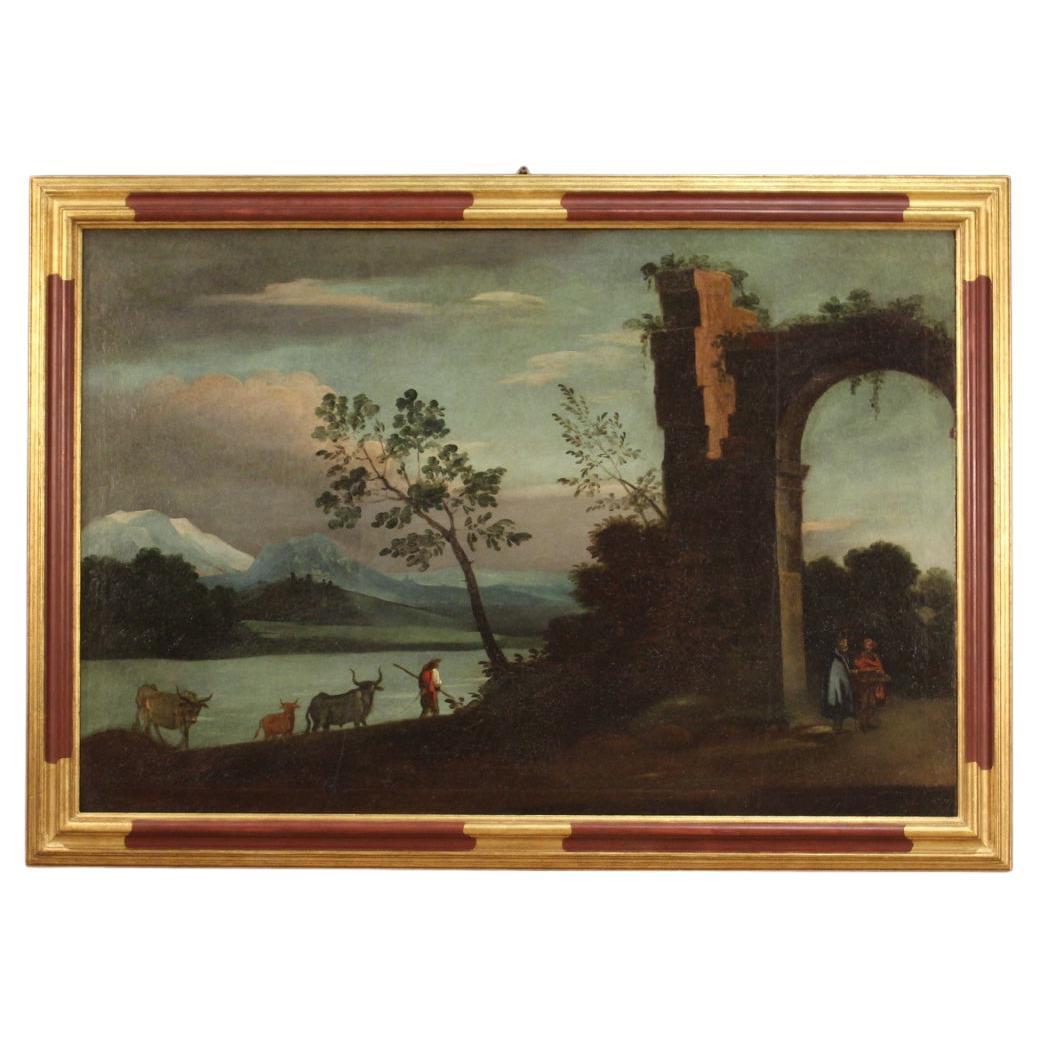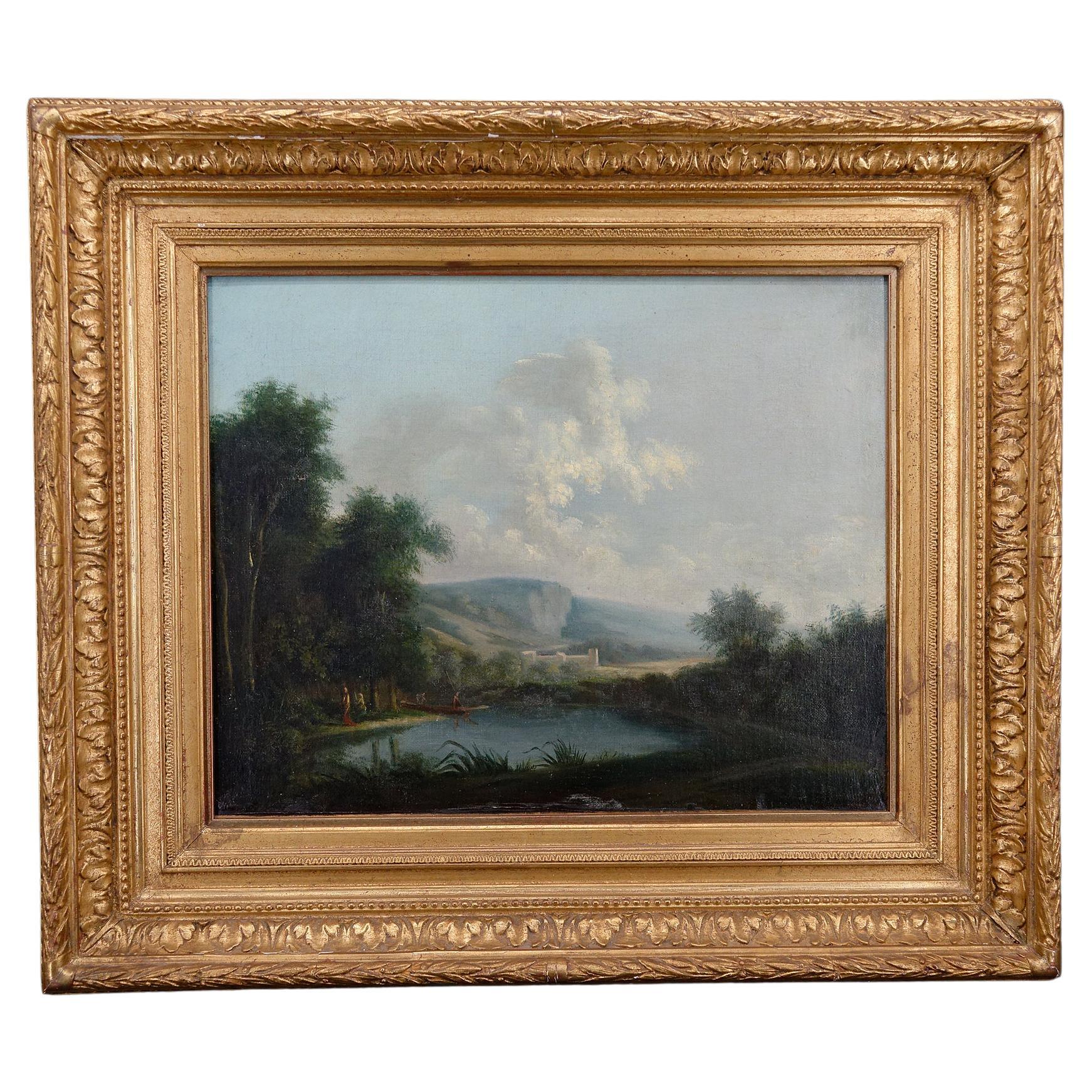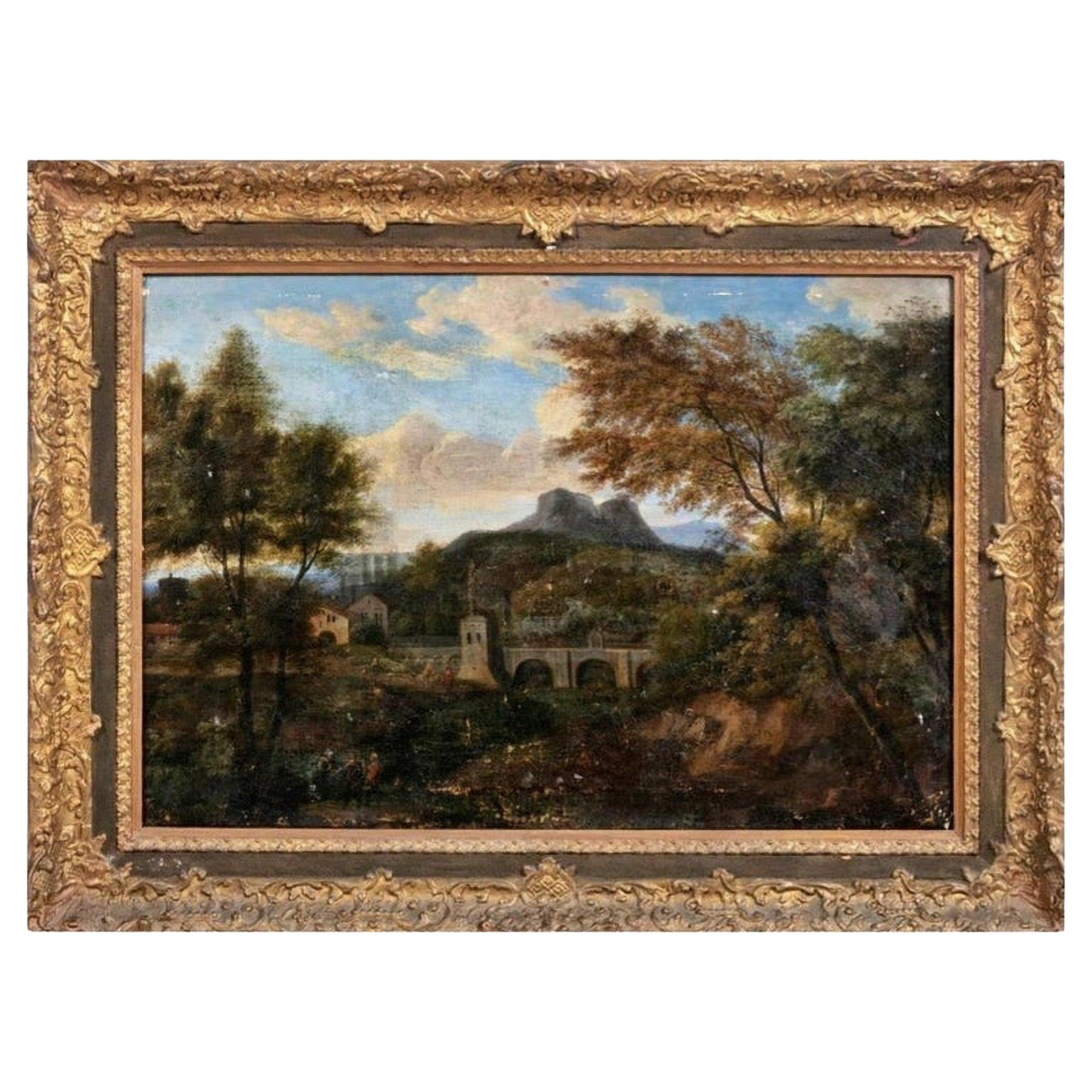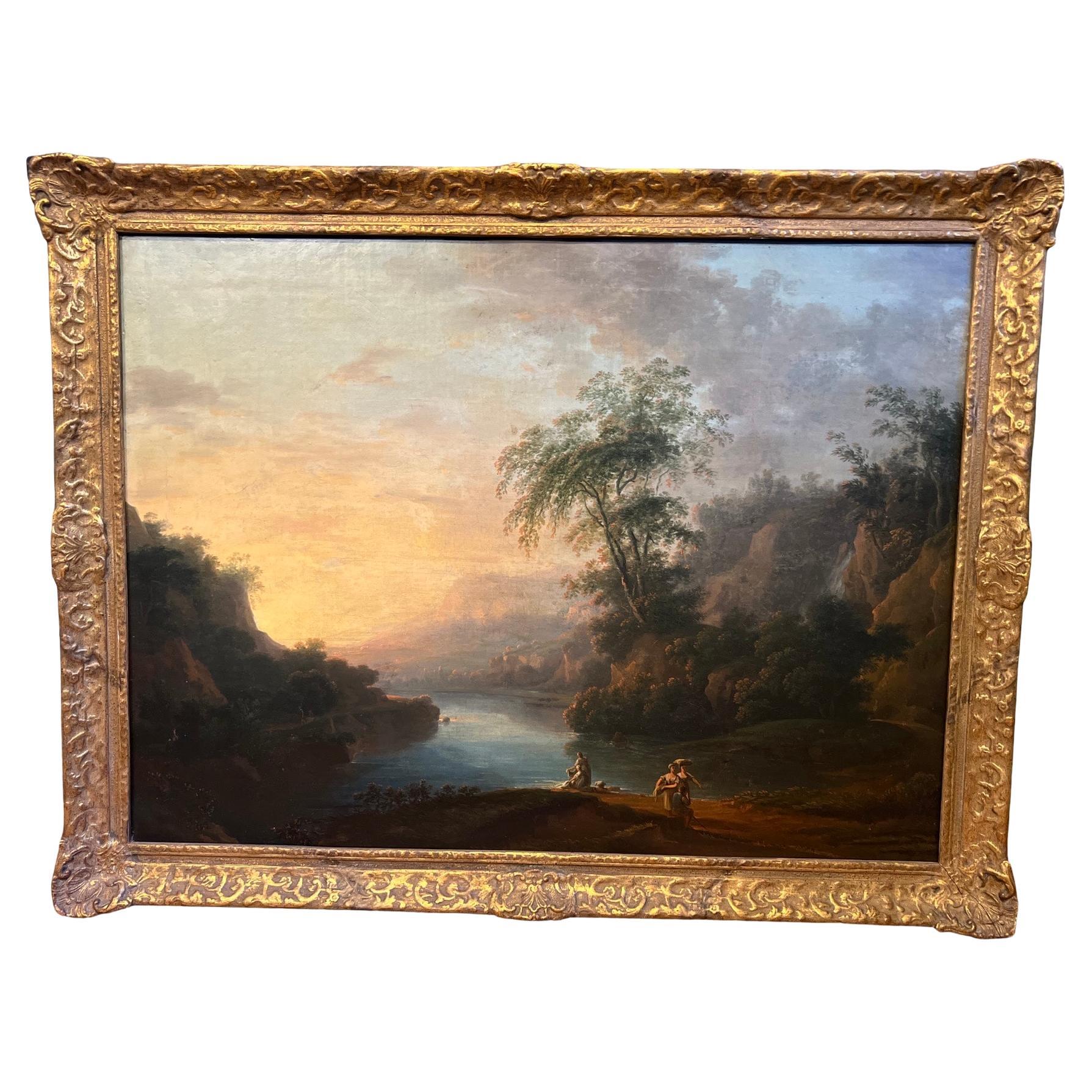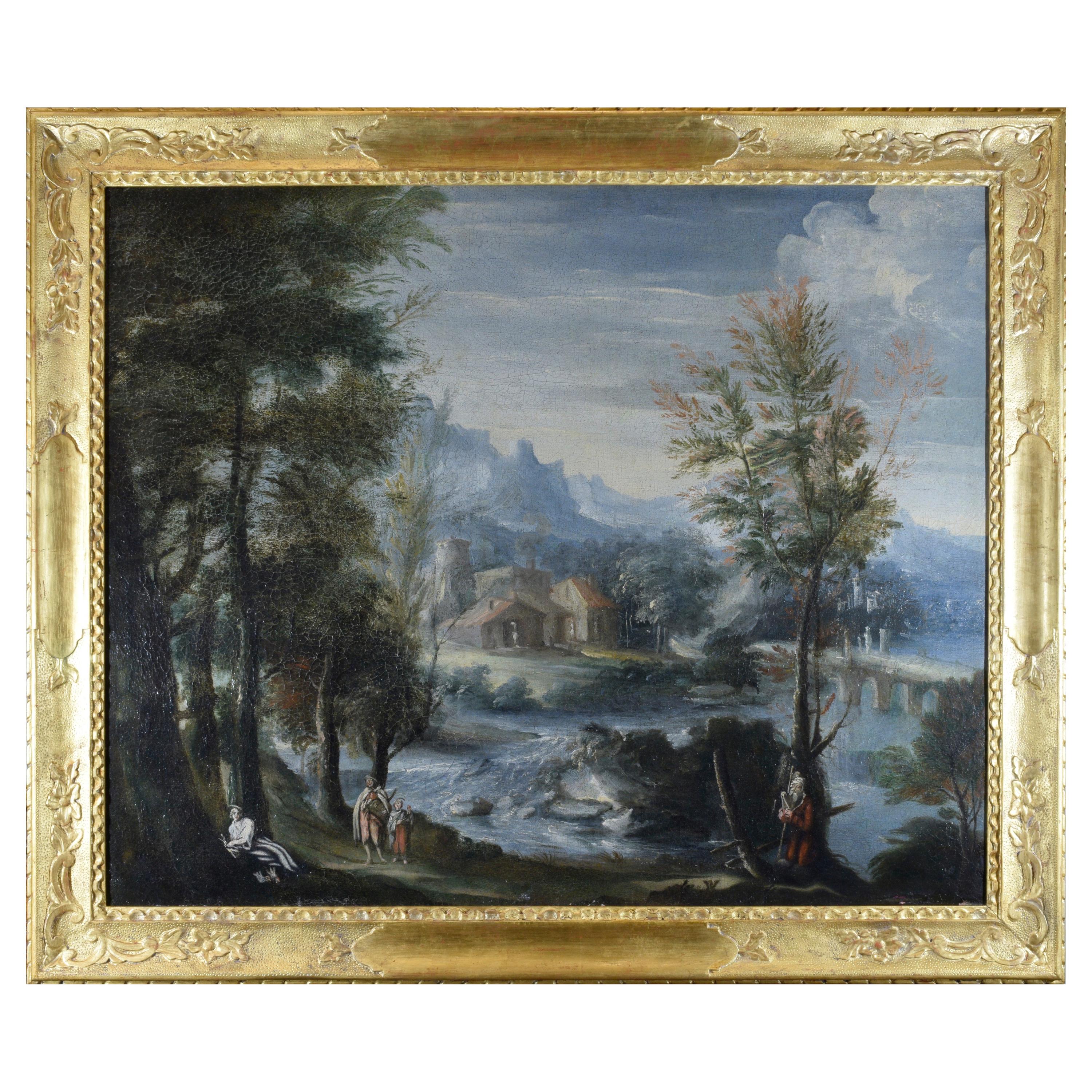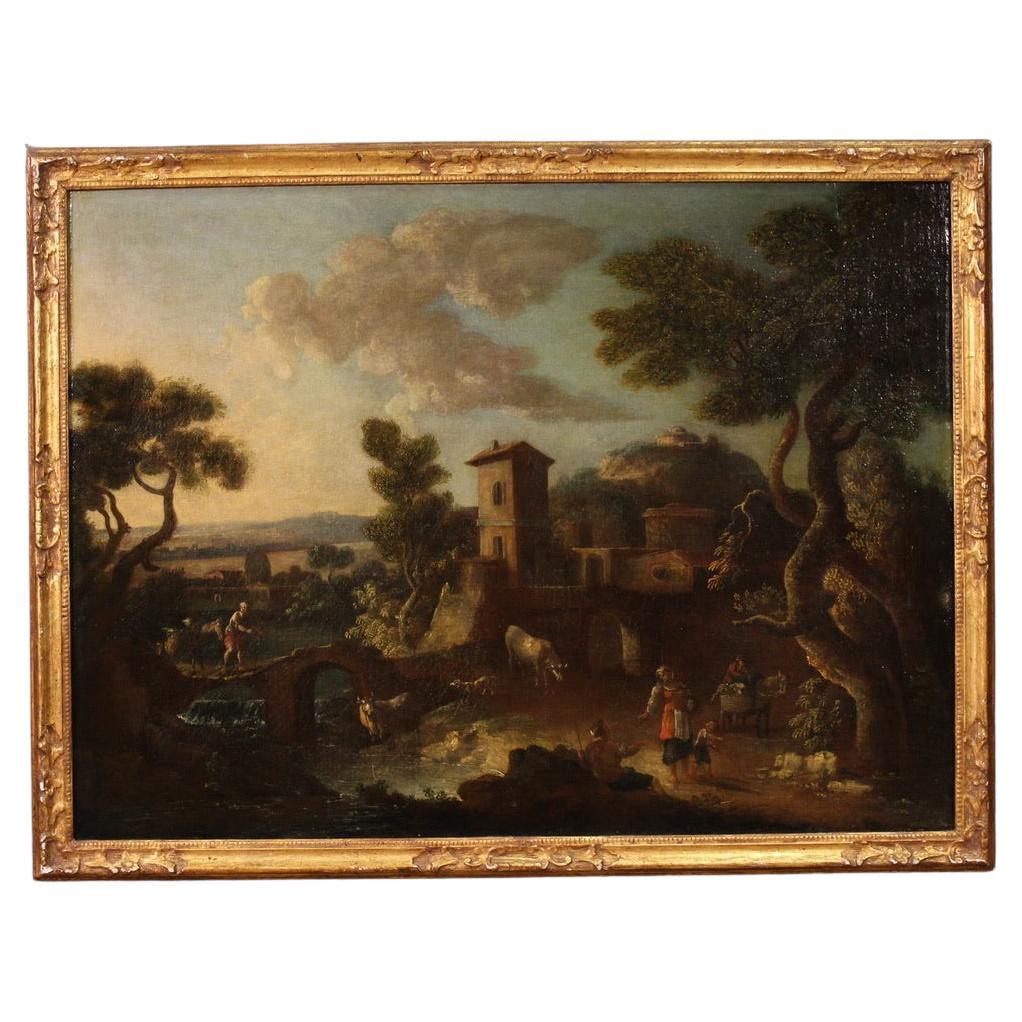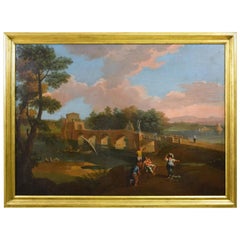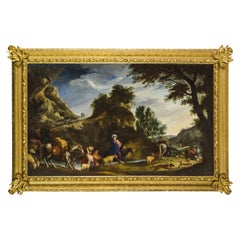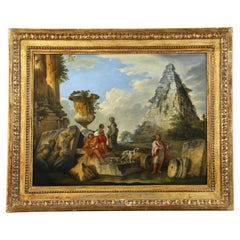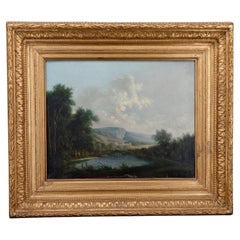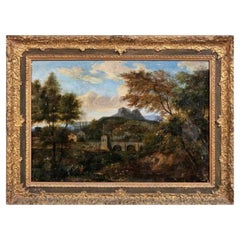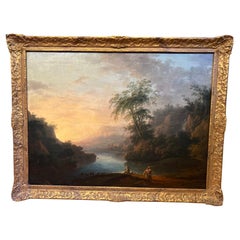Items Similar to 18th Centuy, Italian Painting with Landscape by Giovanni Battista Colomba
Want more images or videos?
Request additional images or videos from the seller
1 of 17
18th Centuy, Italian Painting with Landscape by Giovanni Battista Colomba
$22,064.89
$27,581.1220% Off
£16,414.05
£20,517.5620% Off
€18,400
€23,00020% Off
CA$30,214.38
CA$37,767.9820% Off
A$33,594.28
A$41,992.8520% Off
CHF 17,541.08
CHF 21,926.3520% Off
MX$408,924.23
MX$511,155.2920% Off
NOK 223,816.56
NOK 279,770.7020% Off
SEK 209,705.42
SEK 262,131.7720% Off
DKK 140,069.04
DKK 175,086.3020% Off
Shipping
Retrieving quote...The 1stDibs Promise:
Authenticity Guarantee,
Money-Back Guarantee,
24-Hour Cancellation
About the Item
Giovanni Battista Innocenzo Colomba (1713 – 1793)
Landscape with figures
Oil on canvas, Frame H 102 x L 112 x P 8; canvas H 77 x L 87
The valuable painting, attributable to the painter Giovanni Battista Innocenzo Colomba (1713 - 1793), depicts a wooded landscape animated by characters. At the center of the canvas is a bridge with two arches from which flow lively waterfalls, characteristic of the works of the painter. In addition to the bridge, built of bricks and crossed by some travelers with steeds, the landscape opens, hilly, and then be bordered by large mountains that clear away. A fortress shows a turreted castle overlooking the void. In the foreground, along a path, several people are caught and portrayed in their daily lives. From the left, a couple of travellers take a break, while a few others, accompanied by horses, continue their journey. In the middle two peasants, she with a wicker basket on her head full of wheat and a scythe in her hand, he sitting, with a stick and a pannier on his shoulders, entertain themselves in a dialogue, while on the right two humble parents pray before a child in need of care. The dramatic scene, full of pathos, exalted by the gestures of comfort and concern of two people who flock, are joined by a couple of friars through a gesture of blessing, reminiscent of the power of faith and hope. It is therefore a work of fine workmanship, very pleasant on the aesthetic level and certainly decorative. However, the landscape and the many characters depicted conceal a richer and more vigorous message of faith that the author develops with discretion and descriptive force. In the work is immediately recognizable the style that distinguishes the works of the mature painter, in which the lively and bright palette is accompanied by fine brushstrokes to form landscapes that oscillate between Rococo and Neoclassicism.
Giovanni Battista Innocenzo Colomba (1713 - 1793) was born in Arogno (Canton Ticino), in a family of painters, plasterers and architects whose founder is Andrea Colomba (1567-1627). He learned painting from his uncle, Luca Antonio Colomba, a painter at the Wüttemberg court in Germany, and around 1737 he was an independent painter in Mainz, where he painted several frescoes and decorations. It is probable that he completed his training at the Academy of Vienna, in those years a fundamental centre of aggregation and cultural exchange. He had an intense activity as a set designer and decorator at various princes. In 1741 in Frankfurt he decorated, with squares and allegorical paintings, the ceiling of Römer’s "Imperial Staircase" (destroyed in World War II), on the occasion of celebrations for the coronation as emperor of Charles VII (12 February 1742). In 1748 he was called to Hamburg where he worked in Schleswig-Holstein (large fresco, in the church of Uetersen with Glorification of the Trinity). In Hanover he became court painter to George II. In 1751 he passed into the service of the Duke of Württemberg. In Ludwigsburg and Stuttgart he had an important position for the grand court festivals.
He is a professor at the Stuttgart Academy of Arts founded by Carlo Eugenio in 1761. By 1763 he worked in Italy: on that date the new theatre was inaugurated in Como, in which Colomba worked for many scenes. In the same city he painted the choir of St. James and the church of the seminary Benzi.
The painter moved to Turin where he took the place of the Galliari brothers signing in 1769 the capitulation with the Society of the Knights that administered the Teatro Regio. Relations with the Turin theatre, where he worked for two seasons until 1771, were however studded with endless quarrels. In the years 1774-1780 he is documented in London as a landscape and stage painter at the King’s Theatre and in 1775 he set up a theatre at Weston Hall for Sir Henry Bridgeman. His stay in London allowed him an early opening towards the pre-Romanesque aesthetic, recognizable in the landscapes he made at that time. From 1780 he settled permanently in Arogno and in 1792 he painted in the church of S. Carlo in Poschiavo in Valtellina three canvases with S. Remigio baptizing Clodoveo, S. Rocco between the plague and the Annunciation. In these last works his style oscillates between classicist aesthetics and that still baroque, obviously in tune with the tastes of the client.
According to tradition he died in Arogno in 1793.
The canvas object of this study presents the unmistakable stylistic manner of the artist. The work can be flanked by several paintings signed or returned with certainty to the production of Giovanni Battista Innocenzo Colomba, where we find the same treatment of atmospheric light, the fronds of trees, of the scenographic compositional system and of great depth of perspective. Equally consistent is the color used, particularly recognizable in reds and greens, in browns and blues.
Several elements return, such as the presence of water, of the wide green fronds described with luministic research and of the lively figures portrayed never in static poses but carefully in capturing a precise moment, giving movement and pathos to what is depicted.
We apologize for any translation errors from Italian. Please contact us to have the expertise in Italian.
- Dimensions:Height: 40.16 in (102 cm)Width: 44.1 in (112 cm)Depth: 3.15 in (8 cm)
- Style:Rococo (Of the Period)
- Materials and Techniques:
- Place of Origin:
- Period:
- Date of Manufacture:Mid-18th Century
- Condition:Wear consistent with age and use.
- Seller Location:IT
- Reference Number:1stDibs: LU4405235391842
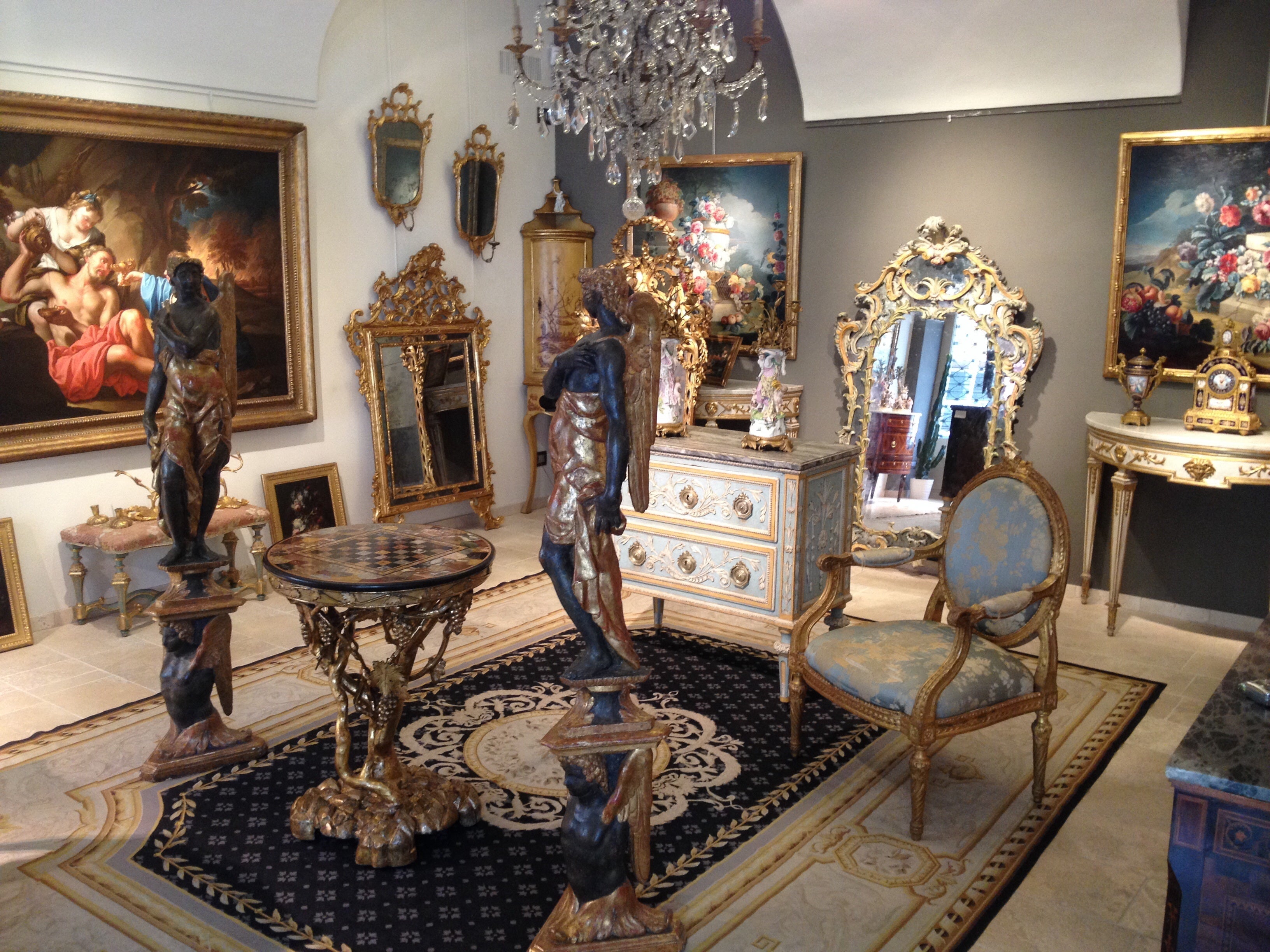
About the Seller
5.0
Platinum Seller
Premium sellers with a 4.7+ rating and 24-hour response times
Established in 1980
1stDibs seller since 2019
56 sales on 1stDibs
Typical response time: 1 hour
- ShippingRetrieving quote...Shipping from: Italy
- Return Policy
Authenticity Guarantee
In the unlikely event there’s an issue with an item’s authenticity, contact us within 1 year for a full refund. DetailsMoney-Back Guarantee
If your item is not as described, is damaged in transit, or does not arrive, contact us within 7 days for a full refund. Details24-Hour Cancellation
You have a 24-hour grace period in which to reconsider your purchase, with no questions asked.Vetted Professional Sellers
Our world-class sellers must adhere to strict standards for service and quality, maintaining the integrity of our listings.Price-Match Guarantee
If you find that a seller listed the same item for a lower price elsewhere, we’ll match it.Trusted Global Delivery
Our best-in-class carrier network provides specialized shipping options worldwide, including custom delivery.More From This Seller
View All18th Century, Italian Painting Depicting Landscape with Watermill and Characters
Located in IT
18th century, Italian painting depicting landscape with watermill and characters
Oil on canvas; Measurements: frame cm L 103.5 x H 127 x P 5; painting L 93 x H 117.5
The painting...
Category
Antique Mid-18th Century Italian Rococo Paintings
Materials
Canvas
Oil on Canvas, Roman Follower of Paolo Anesi, Landscape with Milvio Bridge
Located in IT
Roman School, follower of Paolo Anesi, Roman Landscape with the Milvio Bridge, Half of the 18th Century
Oil on canvas, measures: frame cm W 149 x H 112 x D...
Category
Antique Mid-18th Century Italian Louis XV Paintings
Materials
Canvas
17th Century, Italian Painting by Pier Francesco Cittadini, Jacob and his Family
Located in IT
Pier Francesco Cittadini (Milan, 1616-Bologna, 1681)
"Jacob and his family go to Egypt"
Oil on canvas, cm 109 x 190 (canvas only)
The valuable painting, made in oil on canvas, depicts Jacob and his family go to Egypt and we believe it can be, given the high quality painting, autograph work of Italian Pier Francesco Cittadini (Italy Milan, 1616 - Bologna, 1681) made after 1647. The work, in excellent condition is accompanied by a coeval frame in wood finely carved and golden.
The scene depicted, which was confused with the Flight to Egypt in the past years, is instead identified with the biblical episode of Jacob’s journey. In the foreground, reading the painting from left to right, we see a caravan composed of animals, including donkeys, dromedaries, goats, dogs and horses and people, women, men and slaves, who carry on their journey along the banks of a river, following a path that to the right, would seem to lead to the through of a bridge. In addition to the watercourse is described an environment characterized by large rocks and impervious come far to cover the entire verticality of the canvas. On the left, in the distance, we see the tail of the caravan that runs along the steep path. Large trees enliven and harmonize the environment, as well as white and grey clouds characterize the predominantly clear sky and illuminated on the right by sunlight.
The story is told in the Bible, Book of Genesis, 30, 25, passage in which is described the flight of Jacob from Haran after the contrasts with Laban, father of his wife Rachel. Jacob is the third great patriarch of the Bible. From his descendants originate the twelve generations of the people of Israel. He is the son of Isaac and Rebekah, who led him to flee from the wrath of Esau to Haran to seek refuge from his brother, Laban. At his uncle’s house Jacob met his daughter Rachel. As soon as he saw his cousin, Jacob was taken. Jacob will stay seven years in the service of Laban to marry his beloved Rachel. But Laban, with a deception, will give him in marriage first Lia, the least beautiful eldest daughter, and only after another seven years the splendid Rachel. From his first wife he will have several children, while Rachel will give birth to the beloved son, Joseph, who will become viceroy of Egypt.
After years of service, Jacob asked to be paid with every dark-coloured garment among the sheep and every spotted and dotted garment among the goats. Laban accepted and sent away from his sons all the leaders of that kind. So Jacob took fresh branches of poplar, almond and plane tree, and flayed them, and put them in the troughs. The optical suggestion induced the goats and the sheep to conceive and give birth to dark, striped and dotted garments. He also ensured that all the strongest and healthiest leaders of the flock of Laban would drink near the barked branches, thus assuring a genetic superiority to his part of the flock. His flocks grew numerous and strong and he became richer than his relative, arousing envy. It was clear that Laban would not respect him much longer. At the suggestion of the Lord, Jacob decided to return to Canaan. Trying to avoid any possible dispute, he left with his family while Laban was absent for shearing sheep. But when, three days later, his uncle returned home, he became angry, feeling offended because Jacob had gone secretly and had not allowed him to greet his daughters and grandchildren. In addition, his teraphim, statuettes, or idols, which depicted the family deities, had disappeared. After 7 days of pursuit, Laban and his men reached Jacob’s group on Mount Gilead, in the mountainous region west of the Euphrates River, where his uncle and grandson had a stormy conversation. The younger man was outraged at being accused of stealing idols and told Labano to rummage through his family’s tents at will. Neither of them could know or even imagine that it was Rachel who took the idols and hid them in the saddle of the camel. During the search, she sat down firmly on the saddle, apologizing for not being able to get up, «because I usually have what happens to women» (Gen 31:35). So the loot wasn’t discovered.
The author of this work was inspired by the composition of an engraving by Stefano Della Bella (1610-1664) of circa 1647. The engraving by Stefano della Bella bears the title "Iacob sur ses vieux jours quitte sans fascherie pour voir son filz Ioseph, sa terre et sa patrie" and is signed on the bottom left "Stef. of the Beautiful In. et fe." while on the right it is declared "Cum privil. Regis", that is with license of the king.
Stefano Della Bella (Italy - Florence, May 18, 1610-Florence, July 12, 1664) was born in a family of painters, sculptors and goldsmiths and was left early orphan of his father sculptor, he dedicated himself first to the art of goldsmith at the school of Giovanni Benedetto Castiglione and Gasparo Mola, then turning his attention to drawing and engraving. He soon began drawing figures and copying the etchings of Jacques Callot, which inspired his early works. Under the protection of the Medici, in particular of Don Lorenzo, cadet son of Grand Duke Ferdinand I, Della Bella has the opportunity to make study trips to Rome, where he stayed from 1633-1636; In Rome he met French engravers and publishers of prints such as Israël Henriet and François Langlois, who influenced his decision to move to Paris in 1639, four years after the death of Callot. In Paris he soon reached, thanks to the engravings commissioned by Cardinal Richelieu, the success also worldly; he frequented courtiers, theatre artists and writers, while refusing too oppressive honors. In 1646-1647 he continued his travels in the Netherlands to Amsterdam, Antwerp and Dordrecht. He returned to Florence in 1650 and resumed working under the protection of the Medici court, working for his patrons. In 1656 he became a member of the Academy of Apatists.
The painting object of this study is reasonably attributable to Pier Francesco Cittadini, or Pierfrancesco Cittadini, called the Milanese or the Franceschino (Italy - Milan, 1616-Bologna, 1681) as some exemplary stylistic comparisons proposed to follow can prove.
Pier Francesco Cittadini was an Italian baroque painter, mainly active in Bologna.
His artistic training first took place with the painter Daniele Crespi...
Category
Antique Mid-17th Century European Baroque Paintings
Materials
Canvas, Giltwood
Italian Painting Architectural Capriccio with Caio Cestio Pyramid after Panini
Located in IT
19th century, Italian Painting Architectural Capriccio with the Pyramid of Caio Cestio, Roman painter, after Giovanni Paolo Panini, unsigned.
Dimensions: cm H 48 x W 63.5, frame H 6...
Category
Antique 19th Century Italian Rococo Paintings
Materials
Wood
18th Century, Painting Architectural Capriccio, att. to Isaac De Moucheron
Located in IT
18th Century, Painting with Architectural Capriccio with figures, attributed to Isaac De Moucheron
Measures: canvas cm H 108 x L 152; with frame cm H 132 x L 176 x 8
The painting i...
Category
Antique 18th Century Dutch Baroque Paintings
Materials
Canvas
18th Century, Baroque Austran Painting by August Querfurt
Located in IT
August Querfurt (1696, Wolfenbüttel - 1761, Vienna)
Farmers and villagers at the entrance of a village
Oil on panel , cm 38,5 x 51. frame 66 x 53,5 x 4,5 cm
The valuable painting, ...
Category
Antique 18th Century Austrian Baroque Paintings
Materials
Wood
You May Also Like
18th Century Oil on Canvas Italian Antique Landscape Painting, 1750
Located in Vicoforte, Piedmont
Antique Italian painting from 18th century. Framework oil on canvas, on the first canvas, depicting a view with characters, animals and ruins of good pictorial quality. Large size fr...
Category
Antique 1750s Italian Paintings
Materials
Canvas
Italian painting, lake scene, 19th century
Located in VÉZELAY, FR
In the foreground, a lake surrounded by vegetation.
On the left bank, several figures, some in a boat.
In the background, a building that resembles a fortified castle, in a hilly lan...
Category
Antique 19th Century Italian Grand Tour Paintings
Materials
Canvas, Wood, Paint
$2,878 Sale Price
20% Off
Italian School "Landscape", 18th Century
By Midcentury Italian school
Located in Madrid, ES
Title: Landscape.
Date/Period: 18th century.
Dimension: measures without frame 89cm x 61cm. Frame 15cm in plus. with gold trim.
Materials: Oil on canvas.
Additional information: Ital...
Category
Antique Mid-18th Century Italian Baroque Paintings
Materials
Paint
18th Century, Old Master European Landscape Painting Italian School
Located in Atlanta, GA
Italian School, 18th century.
A masterful example of 18th-century Italian School artistry, this Old Master landscape painting captures the sublime beauty of an idealized European co...
Category
Antique 18th Century Italian Baroque Paintings
Materials
Canvas, Giltwood, Paint
$6,000 Sale Price
20% Off
Italian Landscape Oil on Canvas Early 18th Century Gold Frame Venetian School
Located in Prato, IT
Veneto, Italy, early 18th century
Oil on canvas
20th century frame carved and gilded in pure gold
Dimensions: cm W 93 x H 78,5 x D 5.
Category
Antique Early 18th Century Italian Paintings
Materials
Canvas, Wood
17th Century Oil on Canvas Italian Antique Painting Landscape with Figures, 1680
Located in Vicoforte, Piedmont
Antique Italian painting from the second half of the 17th century. Oil on canvas artwork depicting a wonderful bucolic landscape with a village, common people and grazing animals. Wi...
Category
Antique 1680s Italian Paintings
Materials
Canvas
